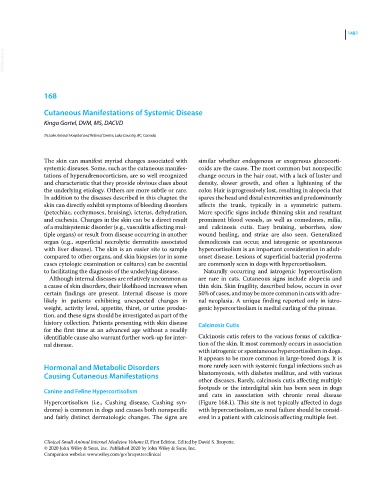Page 1543 - Clinical Small Animal Internal Medicine
P. 1543
1481
VetBooks.ir
168
Cutaneous Manifestations of Systemic Disease
Kinga Gortel, DVM, MS, DACVD
Tri Lake Animal Hospital and Referral Centre, Lake Country, BC, Canada
The skin can manifest myriad changes associated with similar whether endogenous or exogenous glucocorti-
systemic diseases. Some, such as the cutaneous manifes- coids are the cause. The most common but nonspecific
tations of hyperadrenocorticism, are so well recognized change occurs in the hair coat, with a lack of luster and
and characteristic that they provide obvious clues about density, slower growth, and often a lightening of the
the underlying etiology. Others are more subtle or rare. color. Hair is progressively lost, resulting in alopecia that
In addition to the diseases described in this chapter, the spares the head and distal extremities and predominantly
skin can directly exhibit symptoms of bleeding disorders affects the trunk, typically in a symmetric pattern.
(petechiae, ecchymoses, bruising), icterus, dehydration, More specific signs include thinning skin and resultant
and cachexia. Changes in the skin can be a direct result prominent blood vessels, as well as comedones, milia,
of a multisystemic disorder (e.g., vasculitis affecting mul- and calcinosis cutis. Easy bruising, seborrhea, slow
tiple organs) or result from disease occurring in another wound healing, and striae are also seen. Generalized
organ (e.g., superficial necrolytic dermatitis associated demodicosis can occur, and iatrogenic or spontaneous
with liver disease). The skin is an easier site to sample hypercortisolism is an important consideration in adult‐
compared to other organs, and skin biopsies (or in some onset disease. Lesions of superficial bacterial pyoderma
cases cytologic examination or cultures) can be essential are commonly seen in dogs with hypercortisolism.
to facilitating the diagnosis of the underlying disease. Naturally occurring and iatrogenic hypercortisolism
Although internal diseases are relatively uncommon as are rare in cats. Cutaneous signs include alopecia and
a cause of skin disorders, their likelihood increases when thin skin. Skin fragility, described below, occurs in over
certain findings are present. Internal disease is more 50% of cases, and may be more common in cats with adre-
likely in patients exhibiting unexpected changes in nal neoplasia. A unique finding reported only in iatro-
weight, activity level, appetite, thirst, or urine produc- genic hypercortisolism is medial curling of the pinnae.
tion, and these signs should be investigated as part of the
history collection. Patients presenting with skin disease Calcinosis Cutis
for the first time at an advanced age without a readily
identifiable cause also warrant further work‐up for inter- Calcinosis cutis refers to the various forms of calcifica-
nal disease. tion of the skin. It most commonly occurs in association
with iatrogenic or spontaneous hypercortisolism in dogs.
It appears to be more common in large‐breed dogs. It is
Hormonal and Metabolic Disorders more rarely seen with systemic fungal infections such as
Causing Cutaneous Manifestations blastomycosis, with diabetes mellitus, and with various
other diseases. Rarely, calcinosis cutis affecting multiple
footpads or the interdigital skin has been seen in dogs
Canine and Feline Hypercortisolism
and cats in association with chronic renal disease
Hypercortisolism (i.e., Cushing disease, Cushing syn- (Figure 168.1). This site is not typically affected in dogs
drome) is common in dogs and causes both nonspecific with hypercortisolism, so renal failure should be consid-
and fairly distinct dermatologic changes. The signs are ered in a patient with calcinosis affecting multiple feet.
Clinical Small Animal Internal Medicine Volume II, First Edition. Edited by David S. Bruyette.
© 2020 John Wiley & Sons, Inc. Published 2020 by John Wiley & Sons, Inc.
Companion website: www.wiley.com/go/bruyette/clinical

